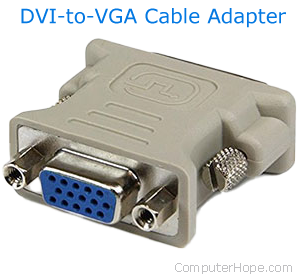How to convert DVI to VGA or VGA to DVI

Today's video technology is moving away from analog (VGA (video graphics array)) for digital connection formats (HDMI, DVI (digital visual interface), DisplayPort). However, you still need to change the display technologies, usually due to differing ports on a computer and display. Video signals may be adapted in either direction (from DVI to VGA and VGA to DVI), but there are certain limitations and expense differences.
DVI to VGA
The DVI-to-VGA adapter is a cable or a small device (shown above). It allows a display device with a VGA connector (input) to receive an analog signal from a DVI-A (analog only) or DVI-I (analog and digital) connector attached to a computer's GPU (graphics processing unit). The converters are inexpensive and occasionally packaged with video cards and available at online retailers for around $5.
VGA to DVI
There's also the less common scenario where a GPU on an older computer needs to send its signal to a newer display device with no VGA connector. In this case, a VGA-to-DVI converter is required to digitally represent an analog signal. These devices are harder to locate and often cost upwards of $100. If you are in this situation, we recommend upgrading your video card or buying a new computer.
Signal quality considerations
Please note that moving between these two technologies may cause you to experience a loss of video quality. VGA, even in its highest resolution from SVGA (super video graphics array), is only capable of an 800 x 600-pixel resolution. Therefore, if your computer sends a higher resolution DVI signal, it will be restricted by the lower resolution of VGA. Additionally, analog VGA signals are susceptible to a loss of quality based on how the cable was made.
